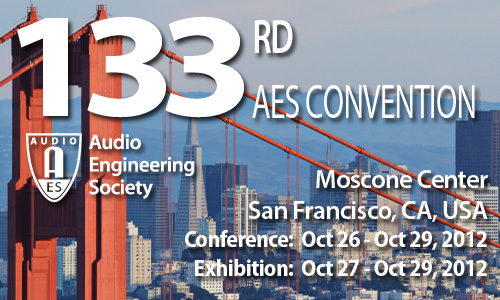
AES San Francisco 2012
Product Design Track Event EB1
Saturday, October 27, 10:00 am — 11:30 am (Foyer)
Engineering Brief: EB1 - eBrief Presentations—Posters 1
EB1-1 Accuracy of ITU-R BS.1770 Algorithm in Evaluating Multitrack Material—Pedro Duarte Pestana, CITAR-UCP - Almada, Portugal; CEAUL-FCUL; Alvaro Barbosa, Universidade Lisboa - Lisbon, Portugal
Loudness measurement that is computationally efficient and applicable on digital material disregarding listening level is a very important feature for automatic mixing. Recent work in broadcast specifications of loudness (ITU-R BS.1770) deserved broad acceptance and seems a likely candidate for extension to multitrack material, though the original design did not bear in mind this kind of development. Some empirical observations have suggested that certain types of individual source materials are not evaluated properly by the ITU’s algorithm. In this paper a subjective test is presented that tries to shed some light on the subject.
Engineering Brief 53 (Download now)
EB1-2 An Online Resource for the Subjective Comparison of Vocal Microphones—Bradford Swanson, University of Massachusetts - Lowell - Lowell, MA, USA
Forty-eight microphones were gathered into small groups and tested using four vocalists (two male, two female). The recorded results are collected online so users may subjectively compare a single performance on closely related microphones.
Engineering Brief 54 (Download now)
EB1-3 Perception of Distance and the Effect on Sound Recording Distance Suitability for a 3-D or 2-D Image—Luiz Fernando Kruszielski, Tokyo University of the Arts - Adachi-ku, Tokyo, Japan; Toru Kamekawa, Tokyo University of the Arts - Tokyo, Japan; Atsushi Marui, Tokyo University of the Arts - Adachi-ku, Tokyo, Japan
Possible differences in the perception of the sound caused by 3-D image are still unclear. The aim of this research is to understand a possible difference in the perception of distance caused by interaction of sound and 3-D image compared to a 2-D image and also how this could affect the suitability of the sound recording distance. Using a 3-D setup, a saxophone player was recorded at five different distances. The subjects where asked to judge their subjective distance and also the suitable sound for the presented image. The results show that one group perceived 3-D to be more distant, however it did not change the sound suitability compared 3-D to 2-D.
Engineering Brief 55 (Download now)
EB1-4 Modeling Auditory-Haptic Interface Cues from an Analog Multi-line Telephone—Durand Begault, Human Systems Integration Division, NASA Ames Research Center - Moffett Field, CA, USA; Mark R. Anderson, Dell Systems, NASA Ames Research Center - Moffett Field, CA, USA; Rachel M. Bittner, New York University - New York, NY, USA
The Western Electric company produced influential multi-line telephone designs during the 1940s–1970s using a six-button interface (line selection, hold button, intercom). Its simplicity was an example of a successful human factors design. Unlike touchscreen or membrane switches used in its modern equivalents, the older multi-line telephone used raised surface mechanical buttons that provided robust tactile, haptic, and auditory cues. This multi-line telephone was used as a model for a trade study comparison of two interfaces: a touchscreen interface (iPad) versus a pressure-sensitive strain gauge button interface (Phidget USB interface controllers). This engineering brief describes how the interface logic and the visual and auditory cues of the original telephone were analyzed and then synthesized using MAX-MSP. (The experiment and results are detailed in the authors' AES 133rd convention paper "Multimodal Information Management: Evaluation of Auditory and Haptic Cues for NextGen Communication Displays").
Engineering Brief 56 (Download now)
EB1-5 Tailoring Practice Room Acoustics to Student Needs—Scott R. Burgess, Central Michigan University - Mt. Pleasant, MI, USA
A crucial part of any music education facility is the student practice rooms. While these rooms typically vary in size, the acoustic treatments often take a "one size fits all" approach. This can lead to student dissatisfaction and a lack of rooms that are suitable to some instruments. The School of Music at Central Michigan University surveyed our students and created a variety of acoustic environments based on the results of this survey. This presentation will discuss this process and the results of the follow-up survey, which indicates an improvement in student satisfaction, along with suggestions for further study.
Engineering Brief 57 (Download now)
EB1-6 Acoustic Properties of Small Practice Rooms Where Musicians Can Practice Contentedly: Effect of Reverberation on Practice—Ritsuko Tsuchikura, SONA Corp. - Nakano-ku, Tokyo, Japan; Masataka Nakahara, ONFUTURE Ltd. - Tokyo, Japan; SONA Corp. - Tokyo, Japan; Takashi Mikami, SONA Co. - Tokyo, Japan; Toru Kamekawa, Tokyo University of the Arts - Tokyo, Japan; Atsushi Marui, Tokyo University of the Arts - Adachi-ku, Tokyo, Japan
This paper describes results of study on practice room acoustics regarding the level of satisfaction players feel about the acoustical conditions. Two different factors are found to be involved for musicians to evaluate the acoustics of
practice rooms: "comfort in practice" and "comfort in performance." Further evaluation of the two factors shows that "comfort in practice" and "comfort in performance" have different desired reverberation times. The average absorption coefficients, therefore, are estimated. Though the experiments were carried out on several kinds of instruments, this paper describes the results of experiments involving trumpeters and violinists.
Engineering Brief 58 (Download now)
EB1-7 Bellamy Baffle Array: A Multichannel Recording Technique to Improve Listener Envelopment—Steven Bellamy, Humber College - Toronto, ON, Canada
The paper outlines a 6-microphone technique that makes use of a baffle between front and rear arrays. This addresses three common challenges in multichannel recording for 5.1 channel playback. First, to improve the sense of connectedness between LS/RS, L/LS and R/RS channel pairs. Second, to maintain clarity of the direct sound while allowing for strong levels of room sound in the mix. Third, to provide a flexible system that can work well with a variety of ensembles. The result is a flexible microphone technique that results in recordings of increased clarity and envelopment.
Engineering Brief 59 (Download now)
